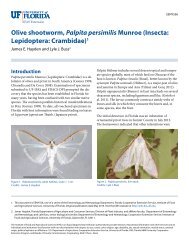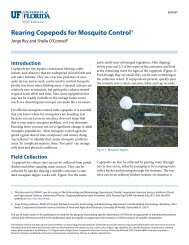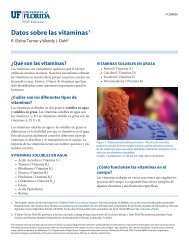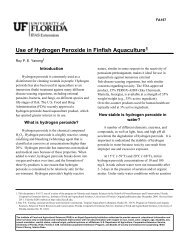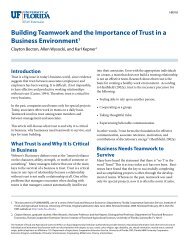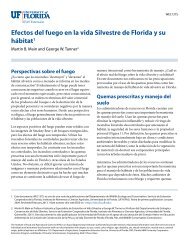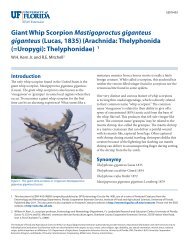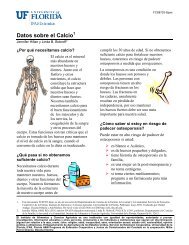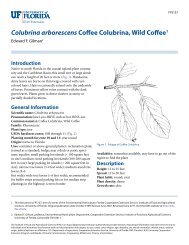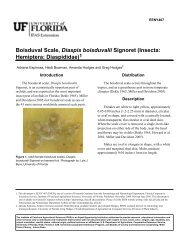Florida Dampwood Termites, Neotermes castaneus - EDIS ...
Florida Dampwood Termites, Neotermes castaneus - EDIS ...
Florida Dampwood Termites, Neotermes castaneus - EDIS ...
Create successful ePaper yourself
Turn your PDF publications into a flip-book with our unique Google optimized e-Paper software.
<strong>Florida</strong> <strong>Dampwood</strong> <strong>Termites</strong>, <strong>Neotermes</strong> <strong>castaneus</strong> (Burmeister), <strong>Neotermes</strong> jouteli (Banks),.... 2<br />
jouteli extends from Vero Beach to the Keys, while<br />
N. luykxi, a relatively newly discovered species, has<br />
been collected from eastern Broward County to Key<br />
Largo.<br />
Figure 1. Distribution of <strong>Neotermes</strong> species in <strong>Florida</strong>.<br />
Credits: Rudolf H. Scheffrahn, University of <strong>Florida</strong><br />
Description and Identification<br />
Colonies of dampwood termites consist of three<br />
primary castes: the reproductives (king, queen, and<br />
unmated winged forms called alates), soldiers, and<br />
false workers or pseudergates (Figure 2). <strong>Neotermes</strong><br />
pseudergates are immature forms without external<br />
signs of wings. When wing buds become visible after<br />
molting, they are called nymphs. The pseudergates<br />
and nymphs excavate and feed on wood to nourish<br />
themselves and their nestmates. Eggs and newly<br />
hatched termites, called larvae, are usually found near<br />
the king and queen. Soldiers constitute about 5% of<br />
the colony population.<br />
A month or two before dispersal flights, nymphs<br />
with long wing buds appear and gradually molt into<br />
alates. <strong>Neotermes</strong> alates are large and have two pairs<br />
of wings that are lightly creased along their vein<br />
paths. Fore wings and hind wings are about equal in<br />
size and shape. Each fore wing has five pigmented<br />
and enlarged veins (costal margin, subcosta, radius,<br />
radial sector, and median) near where they attach to<br />
the body (Figure 3). The enlarged median vein<br />
distinguishes <strong>Neotermes</strong> alates from all other termites<br />
in <strong>Florida</strong> (Figure 4).<br />
Figure 2. Castes in a <strong>Neotermes</strong> <strong>castaneus</strong> (Burmeister)<br />
colony. Credits: Rudolf H. Scheffrahn, University of <strong>Florida</strong><br />
Figure 3. <strong>Neotermes</strong> fore wings. Credits: Rudolf H.<br />
Scheffrahn, University of <strong>Florida</strong><br />
Figure 4. <strong>Neotermes</strong> jouteli (Banks) alate and alates of two<br />
drywood termite species found in <strong>Florida</strong>, Incisitermes<br />
snyderi and Cryptotermes brevis. Credits: Rudolf H.<br />
Scheffrahn, University of <strong>Florida</strong>



